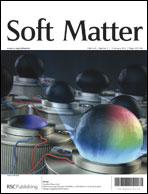Surface wrinkling and folding of core–shell soft cylinders
Abstract
Constrained swelling or shrinkage of such soft materials as elastomers, polymeric hydrogels, and biological tissues can create various surface patterns through surface wrinkling and subsequent morphological evolution. Here we study, both theoretically and numerically, the swelling-driven surface wrinkling and pattern evolution of cylindrical elastomers with core–shell structure. The results demonstrate that the system may buckle into different morphologies under different geometric and material parameters. When the swelling of the shell or the shrinkage of the core reaches a threshold, the cylindrical surface will first buckle into a periodically buckling pattern. With further swelling/shrinkage, wrinkle-to-fold transition may occur, rendering a period-doubling surface topography. The energetic mechanisms underlying this process of wrinkling pattern evolution are analyzed. This study not only benefits the understanding of the morphogenesis in soft materials and tissues (e.g., tumors), but also opens a new avenue for the fabrication of multi-periodic or aperiodic patterns on curved surfaces through self-organization.


 Please wait while we load your content...
Please wait while we load your content...